Contemporary Histories: The 2009 International Competition for Curatorship in Ukraine (Article)
What is the creative potential of a situation where old conservative institutional practice meets new energy and ideas? Can we begin to value the living qualities of art stored in traditional museums by animating it with new points of view?
2009 saw the realization of eight curatorial projects that position contemporary art in the context of traditional Ukrainian museums. These projects were among the finalists selected by international jury in the competition “Art a priori: Contemporary Histories” sponsored by the EIDOS Arts Development Foundation. The competition was initiated in response to a visible need for Ukrainian contemporary art to address the issue of its identity or national specificity. Furthermore, recognizing a recent trend in European contemporary art exhibitions situated in traditional museum contexts, EIDOS president Ludmila Bereznitsky proposed that emerging curators and contemporary artists could offer new insight into the history of Ukrainian art and revitalize Ukraine’s traditional museums.
 The “Art a priori” competition served as a research laboratory and a training ground. There were next to no precedents for contemporary art projects in traditional museums and no directions on how to approach the hosting institutions. It was a “trial by fire” educational experience for all involved, from the EIDOS administration, to the young curators (most of whom had little or no previous experience), to the museum staff who had to adapt their policies and conventions about art to meet new demands. While the competition announcement and individual projects were ambitious, the process of their realization illuminated inherent limitations in Ukrainian museums as traditional institutions, as well as in the public comprehension of contemporary art.
The “Art a priori” competition served as a research laboratory and a training ground. There were next to no precedents for contemporary art projects in traditional museums and no directions on how to approach the hosting institutions. It was a “trial by fire” educational experience for all involved, from the EIDOS administration, to the young curators (most of whom had little or no previous experience), to the museum staff who had to adapt their policies and conventions about art to meet new demands. While the competition announcement and individual projects were ambitious, the process of their realization illuminated inherent limitations in Ukrainian museums as traditional institutions, as well as in the public comprehension of contemporary art.
The EIDOS-sponsored projects took place all over Ukraine: three in Kyiv, two in Kharkiv, one each in Sevastopol, Odessa, and in the Vyshnivetsky Palace and Park in Ternopil oblast (region). The projects took many forms, from elaborate installations to a festival where visitors could interact with artists creating new works on site, to a performance that lasted the entire working day of the museum.
The Kharkiv-based artists’ collective SOSka proposed an exhibition titled “A New History” for the Kharkiv Art Museum. It included works by artists from Ukraine, Russia, Slovakia, Romania and Sweden; some pieces had been shown previously in international exhibitions such as Manifesta 7 and Art Moscow. Adopting a structure similar to curator Ekaterina Degot’s exhibition “Thinking Realism” in the State Tretiakov Gallery in Moscow (2007), the curators paired contemporary artworks (mostly video) with works from the permanent collection in order to raise questions and introduce the possibility for new readings. In Kharkiv, the contemporary art objects were juxtaposed with historical paintings and sculptures, creating a visual and aural dissonance that was perceived by museum administrators as a conflict, rather than as a dialogue as the curators had intended.
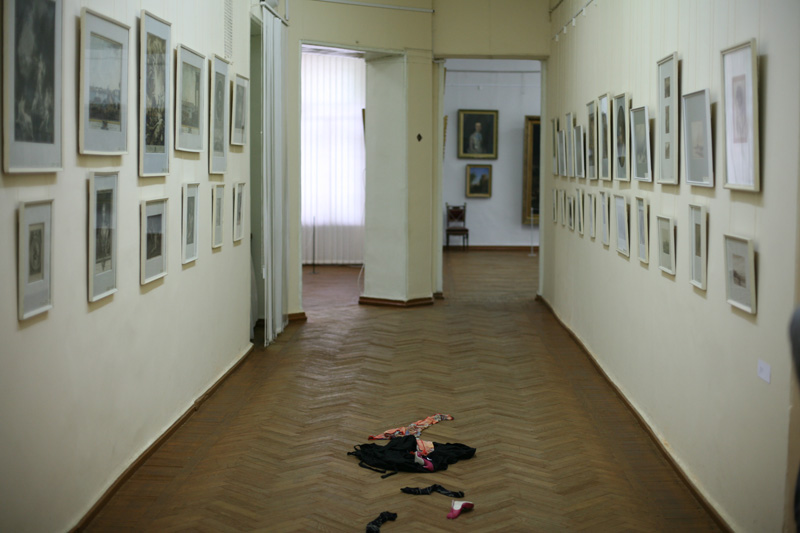 “A New History” was scheduled for five days, but it was abruptly closed by order of the museum director, Valentina Myzgina, the day after the opening. In an official letter of explanation sent to the EIDOS foundation president two weeks later, Myzgina cited several reasons for shutting down the exhibition. These included concerns that video artworks were installed so close to museum paintings that they interfered with viewing the paintings. Some video works broadcast sound into the gallery rather than through headphones, and they contained offensive language. David Ter-Oganyan’s installation “Girl in Underwear,” which was not discussed and approved during initial negotiations between the curators and museum staff, consisted of articles of clothing scattered in the middle of a corridor. Judging this to be a disruption of museum circulation and violation of fire safety norms, the director personally dismantled the piece at the exhibition opening. (Figures 1 and 2).
“A New History” was scheduled for five days, but it was abruptly closed by order of the museum director, Valentina Myzgina, the day after the opening. In an official letter of explanation sent to the EIDOS foundation president two weeks later, Myzgina cited several reasons for shutting down the exhibition. These included concerns that video artworks were installed so close to museum paintings that they interfered with viewing the paintings. Some video works broadcast sound into the gallery rather than through headphones, and they contained offensive language. David Ter-Oganyan’s installation “Girl in Underwear,” which was not discussed and approved during initial negotiations between the curators and museum staff, consisted of articles of clothing scattered in the middle of a corridor. Judging this to be a disruption of museum circulation and violation of fire safety norms, the director personally dismantled the piece at the exhibition opening. (Figures 1 and 2).
The catalogue, “A New History”, includes commentary from Ukrainian and Russian art world figures in response to the exhibition’s early termination. Many criticized the absence of a unified, democratic cultural policy for Ukrainian art institutions. Neither the Ministry of Culture nor individual museums actively support the development of new, experimental art works; rather, they only participate in the process of art-making as a censor. Yet the situation in Kharkiv is complicated, as evidenced by the conflicting stories told by the project curators and the museum director. Negotiations at all levels of Ukrainian life–not only politics–are rarely straightforward and transparent, and this incident only supports the practice.
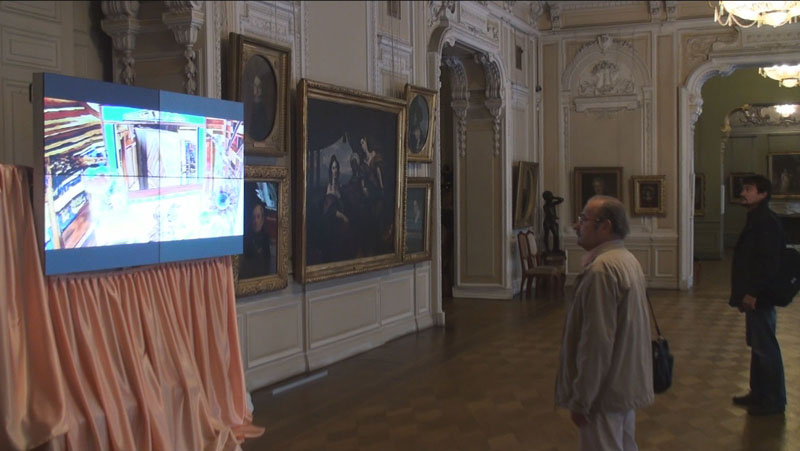 Aside from “A New History,” the only other EIDOS project exhibiting non-Ukrainian artwork was “Videowall” at the Museum of Russian Art in Kyiv. Here curators Eugene Kuchinsky and Iryna Marchenko brought European collective Artists Anonymous to Kyiv virtually, screening in one of the galleries of the Museum of Russian Art a live webcast of their exhibition at the White Square Gallery in Berlin. Meanwhile, a webcast of this screening in the Kyiv museum was streaming in the Berlin gallery. The project raised questions about the possibility for the infinite multiplication of art objects, even at the scale of installations or exhibitions. If a particular work or exhibition can be seen all over the world simultaneously, why travel to see the original? (Figure 3).
Aside from “A New History,” the only other EIDOS project exhibiting non-Ukrainian artwork was “Videowall” at the Museum of Russian Art in Kyiv. Here curators Eugene Kuchinsky and Iryna Marchenko brought European collective Artists Anonymous to Kyiv virtually, screening in one of the galleries of the Museum of Russian Art a live webcast of their exhibition at the White Square Gallery in Berlin. Meanwhile, a webcast of this screening in the Kyiv museum was streaming in the Berlin gallery. The project raised questions about the possibility for the infinite multiplication of art objects, even at the scale of installations or exhibitions. If a particular work or exhibition can be seen all over the world simultaneously, why travel to see the original? (Figure 3).
In the local context, it also raises questions about Ukrainian contemporary artists looking beyond the borders of Ukraine for inspiration, direction, and recognition. It’s easier (and less expensive) to set up a screen in a Kyiv museum than to actually bring an exhibition of celebrated international artists to Ukraine. And while the corresponding screening of the Kyiv “Videowall” in Berlin elicits thoughts about the infinite multiplication of images, it also acquires a quality of post-Soviet kitsch in the Western European context. “Videowall” thus forges a virtual connection between the Ukrainian and international art scenes, masking the reality of their separateness instead of investigating it.
One of the stated aims of the “Art a priori” competition was “to identify contemporary Ukrainian art in the European and global context.” Organizers originally anticipated the inclusion of international curators’ projects. According to project coordinator Tetyana Filevska, the 55 proposals submitted to the jury included curators from Estonia, the United States, Poland and Russia. She speculates that most projects by non-Ukrainian curators were rejected because they did not demonstrate enough familiarity with the local art scene due to difficulties getting information about Ukrainian museums abroad. At present, very few traditional Ukrainian art museums have comprehensive information in English on the Web or English-speaking staff. Thus these museums remain relatively closed to an international public, even to other artists and curators interested in collaboration.
While minimal financial and technical resources limit the scope of local and international outreach programs in Ukrainian museums, perhaps there is also something intentional in maintaining an insular position. I observed that most of the EIDOS-sponsored projects–regardless of their scale or effort in preparation–were open to the public for no more than a week. For example, the Museum of Russian Art, whose director Yuriy Vakulenko actively promoted “Art a priori” and served on the competition jury, showed “Videowall” for a week, except the museum was only open for four of those days.
Filevska upheld my suspicions: “I think it has to do with a fear of contemporary art, which is still widespread in society in general, and especially in museums. I think museums often consider contemporary art as an enemy to themselves and to their art, and they are always waiting to be attacked by contemporary art.” Yet cultural institutions also feel a certain obligation to support new art projects and curiosity toward the experimental. So they commit to hosting a contemporary art project and then express their fear by limiting the project’s scale (in space and time). As if in that way, it couldn’t do too much damage.
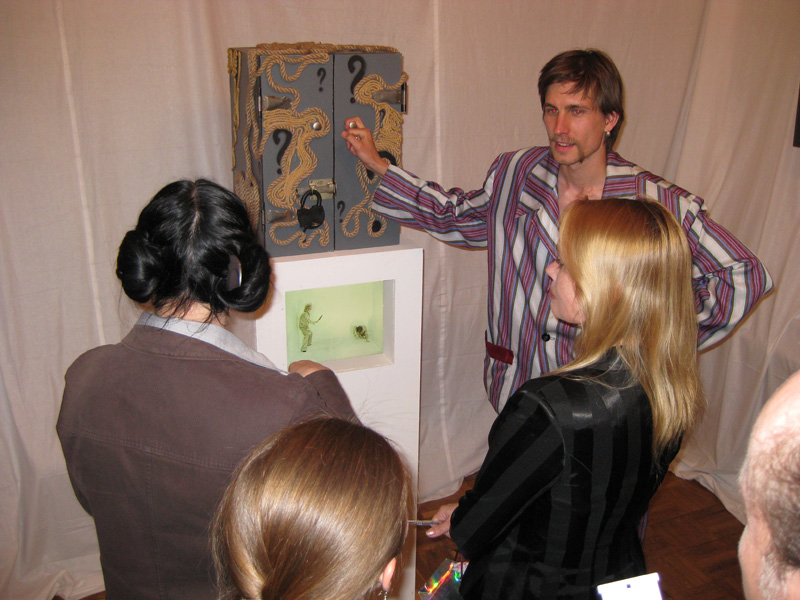 For the exhibition event “A Thing in Itself” at the Odessa O. Bleshunov Municipal Museum of Private Collections, curators Olena Afanasyeva and Maryna Pluzhnyk-Hladyr draped the museum interiors in white cloth, thereby obscuring the permanent collection. Five museum objects were enclosed in boxes and surrounded by new artworks inspired by the hidden objects. Visitors were led on a tour of the galleries and asked to guess what objects were in the boxes. The overly theatricalized excursion-quest–reminiscent of Ukrainian party games–inadvertently overshadowed the initial whimsical radicality of the curators’ spatial transformation.
For the exhibition event “A Thing in Itself” at the Odessa O. Bleshunov Municipal Museum of Private Collections, curators Olena Afanasyeva and Maryna Pluzhnyk-Hladyr draped the museum interiors in white cloth, thereby obscuring the permanent collection. Five museum objects were enclosed in boxes and surrounded by new artworks inspired by the hidden objects. Visitors were led on a tour of the galleries and asked to guess what objects were in the boxes. The overly theatricalized excursion-quest–reminiscent of Ukrainian party games–inadvertently overshadowed the initial whimsical radicality of the curators’ spatial transformation.
(Figure 4).
For his “Art Studies in the Vyshnivetsky Palace,” curator Zorian Bezkorovayny used a conventional approach to enliven the spaces of the Vyshnivetsky Palace and Park. In the tradition of open air and folk music festivals, over three days young artists from Ternopil, Yalta, and Lviv created works in an un-restored wing of the Vyshnivetsky Palace, while visitors observed the process and took part as volunteers or actors in performances. All the artworks created during the project were donated to the museum’s collection and are on view until March 2010. Administrators suggested repeating “Art Studies in the Vyshnivetsky Palace” next year as a recurring event.
Another project that opened possibilities for future institutional collaboration was “Incompatible compatibility” at the Kharkiv Literary Museum. Curators Maryna Koneva and Kateryna Mariushkina investigated connections between the Kharkiv art scene at the beginning of the 20th century as represented in the work of Borys Kosaryev (in the museum collection) and the beginning of the 21st (in the photo-video works of Artyom Volokitin and Roman Minin’s paintings). They also organized readings, discussions and concerts by local writers and musicians over the duration of the exhibition. Their installation approach was unobtrusive and sensitive to the museum’s permanent collection. The project was well received, and the museum directors publicly expressed interest in new proposals from young curators.
While some of the winning proposals were submitted by experienced art makers, like SOSka, who have helped shape the young Ukrainian contemporary art scene, most came from curators with hardly any professional experience. To facilitate such newcomers, the EIDOS Foundation organized a two-day workshop with internationally renowned curators Iara Boubnova and Ekaterina Degot. Participants shared their project proposals, received comments and criticism, and learned about practical aspects of curating. Through the process of turning concepts into reality, each curator gained invaluable experience about negotiation, compromise, and the resourcefulness necessary to push a project through expected and unexpected obstacles.
Curator Viktoria Danyliuk’s project, “Art-Labyrinth,” for the Sevastopol M. Kroshytsky Art Museum was recommended for realization, but without financial backing from EIDOS. In spite of this, she found the resources to build a semi-transparent labyrinth to display contemporary artworks in the museum, and a smaller installation at the nearby Green Pyramid Gallery. Contemporary art had never been a recognized public phenomenon in Sevastopol and thus, in addition to the exhibition, Danyliuk organized two round-table discussions about the project’s theoretical foundations for participating artists, representatives from the museum and EIDOS, and other art professionals.
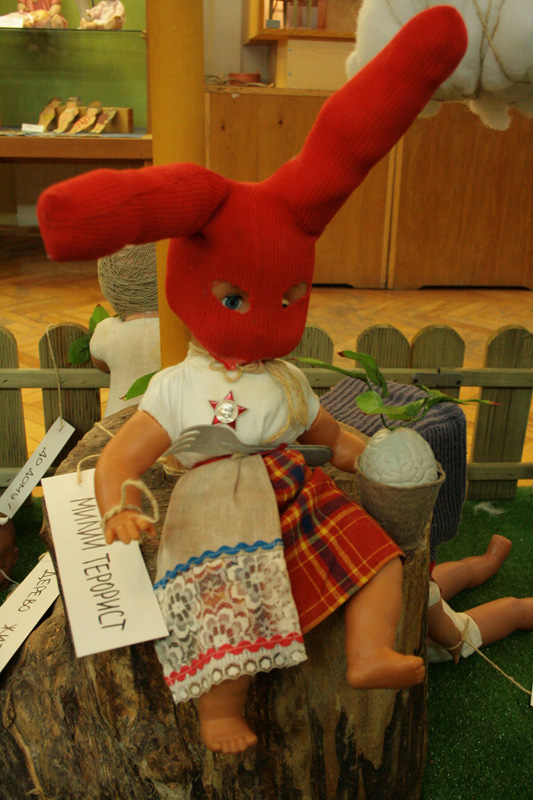
 Many Ukrainian art institutions have a narrow definition of what constitutes art in the traditional museum setting. “Little Stories,” an installation of reassembled children’s toys by Oleksandr Volovodovsky and curated by Nadiyka Pereviznyk, had to be modified to gain access to the Kyiv National Toy Museum and its young audience. The initial proposal, which included dismembered Barbie and Ken dolls, reconfigured to raise questions about toys and gender stereotypes, was rejected by the museum. So both curator and artist consulted with psychologists and educators in addition to the museum staff to develop their exhibition for the Toy Museum’s audience. The result was an “internal universe” of deconstructed and reconfigured toys on the floor in the center of one room. It was more accessible to children than the museum objects in glass cases, but at the same time questioned the familiar notion of children’s toys, thus initiating Kyiv’s youngest museum-goers to the provocative world of contemporary art. (Figures 5a and 5b).
Many Ukrainian art institutions have a narrow definition of what constitutes art in the traditional museum setting. “Little Stories,” an installation of reassembled children’s toys by Oleksandr Volovodovsky and curated by Nadiyka Pereviznyk, had to be modified to gain access to the Kyiv National Toy Museum and its young audience. The initial proposal, which included dismembered Barbie and Ken dolls, reconfigured to raise questions about toys and gender stereotypes, was rejected by the museum. So both curator and artist consulted with psychologists and educators in addition to the museum staff to develop their exhibition for the Toy Museum’s audience. The result was an “internal universe” of deconstructed and reconfigured toys on the floor in the center of one room. It was more accessible to children than the museum objects in glass cases, but at the same time questioned the familiar notion of children’s toys, thus initiating Kyiv’s youngest museum-goers to the provocative world of contemporary art. (Figures 5a and 5b).
As curator of the day-long performance “8” at the National Art Museum of Ukraine in Kyiv, I continue to question the degree to which an artist or curator should compromise the initial project idea in order to make it real. In my case, the director of the first museum I approached with the conceptual idea for a performance refused to cooperate. I turned to the National Art Museum because their administration is more open to innovation and experimentation. But in adapting the project to the available space, its initial provocative quality also changed. Thus the performance resonated more as an artistic precedent than as a work of art.
The performance coincided with another transformative event at the National Art Museum: the “Ukrainian New Wave” exhibition, which displayed for the first time artworks from the mid-1980s through early-1990s by such local contemporary art pioneers as Arsen Savadov, Oleksandr Gnilitsky, and Ilya Chichkan. Both projects reveal a shift in the policy of the National Art Museum toward welcoming contemporary art into its historic context. Contemporary artists may be honored to show their work in one of the nation’s historically prominent art institutions, while the museum hopes that innovative contemporary art projects will increase attendance.
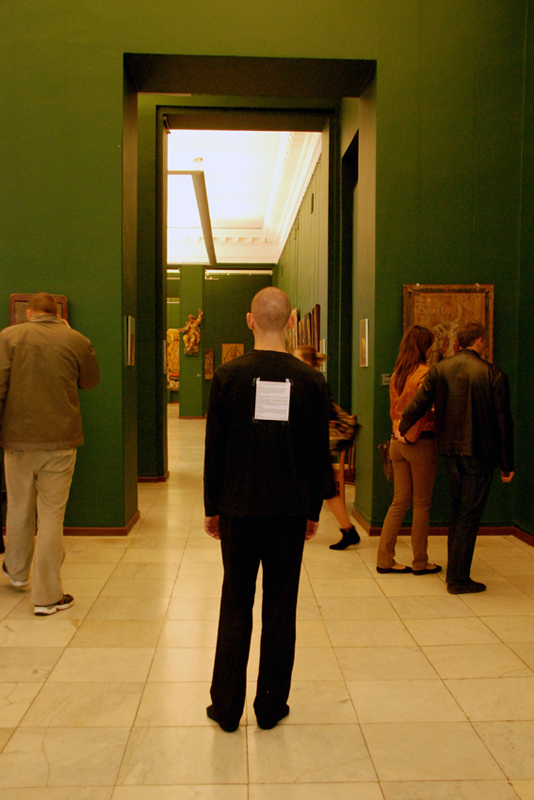
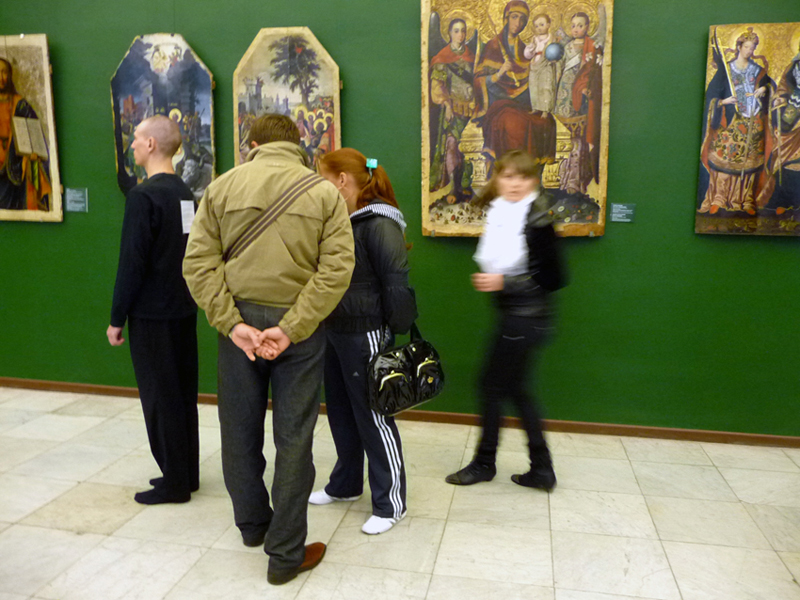 “8” took place in the icon gallery on a Saturday in October. Visitors saw performer Oleksandr Lebediev walking so slowly that it seemed he was standing still. Over the eight-hour working day of the museum, he traversed the space between one end of the gallery and the other, all the time looking intently at one icon in front of him. I spent the day watching visitors watch the performer, some walking up to examine the text on his back, others keeping their distance or trying to ignore him. (Figures 6a and 6b).
“8” took place in the icon gallery on a Saturday in October. Visitors saw performer Oleksandr Lebediev walking so slowly that it seemed he was standing still. Over the eight-hour working day of the museum, he traversed the space between one end of the gallery and the other, all the time looking intently at one icon in front of him. I spent the day watching visitors watch the performer, some walking up to examine the text on his back, others keeping their distance or trying to ignore him. (Figures 6a and 6b).
A number of visitors, as well as the women guarding the icon galleries, were perplexed by this performance. They asked me: What’s going on? How can that be art? I replied with a brief explanation of contemporary art, how it manifests itself in many forms besides painting, sculpture, or photography. I told them that performance art appeared in the 1960s. Many expressed concern about the physical condition of the performer: Aren’t his feet cold? How does he eat or go to the bathroom? So I asked them questions: What do you think about this experience? Is it art?
The “Art a priori” projects opened a space for communication between Ukrainian traditional art institutions and their public and contemporary art, rather than attempting serious institutional critique. The process of realizing conceptual projects trained inexperienced local curators in the rigor and resourcefulness necessary to make an exhibition. These projects also gave a number of artists a unique opportunity to show their work to a museum audience. Even at a modest scale reflecting available financial resources and professional expertise, the projects injected traditional museums with the energy of new ideas and crowds of visitors.
Now it’s up to the institutions and curators to continue pushing boundaries or forging productive connections. Can traditional institutions begin to let go of outmoded ways of thinking about and presenting their collections? Will they open to a broader audience by inviting local initiatives and developing international outreach? Will curators and artists continue to challenge institutional limits in critical and inventive ways? Will institutions who have begun to experiment continue to develop flexibility in their curatorial policies and habits? Will they find the material support to develop new, unconventional projects? Could the ideas proposed through grass-roots projects initiated by individuals, supported by private foundations and implemented through the open-mindedness of key personnel at certain institutions ever “trickle up” to influence the way Ukraine’s government deals with culture?




